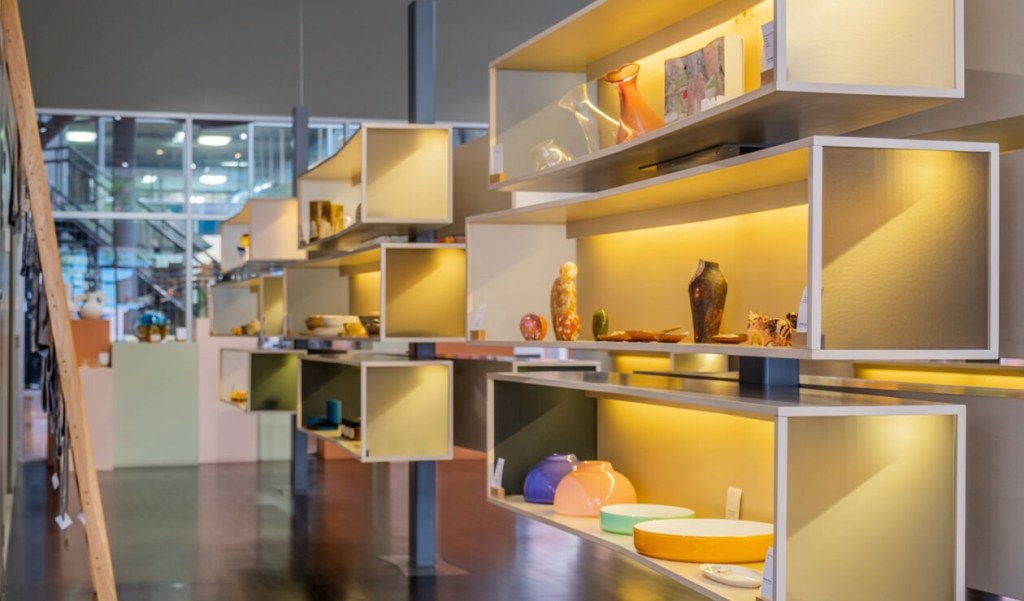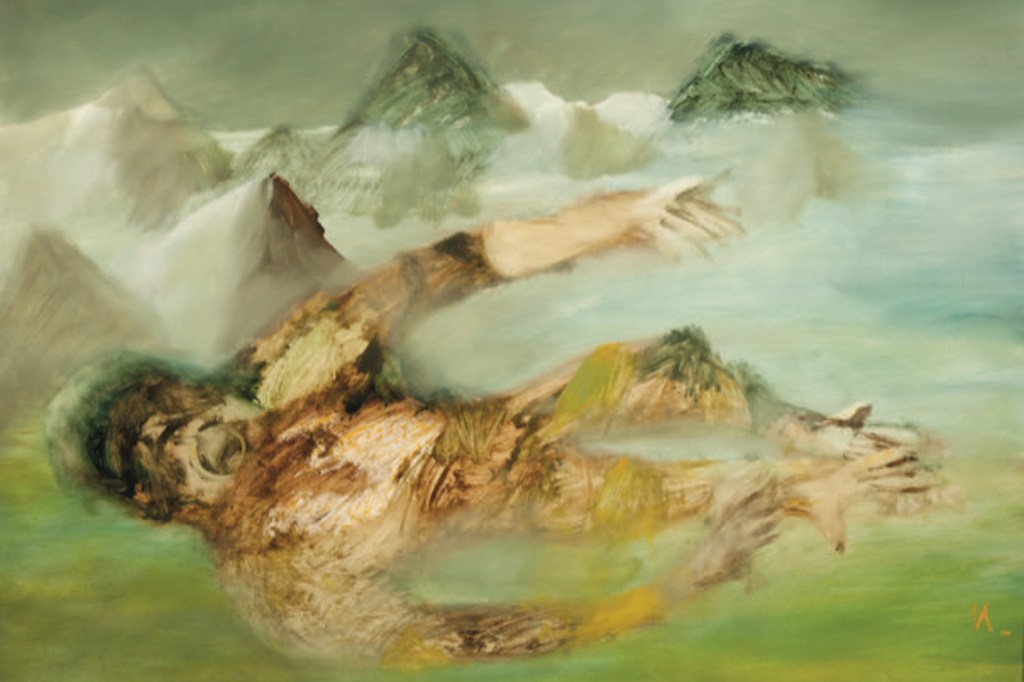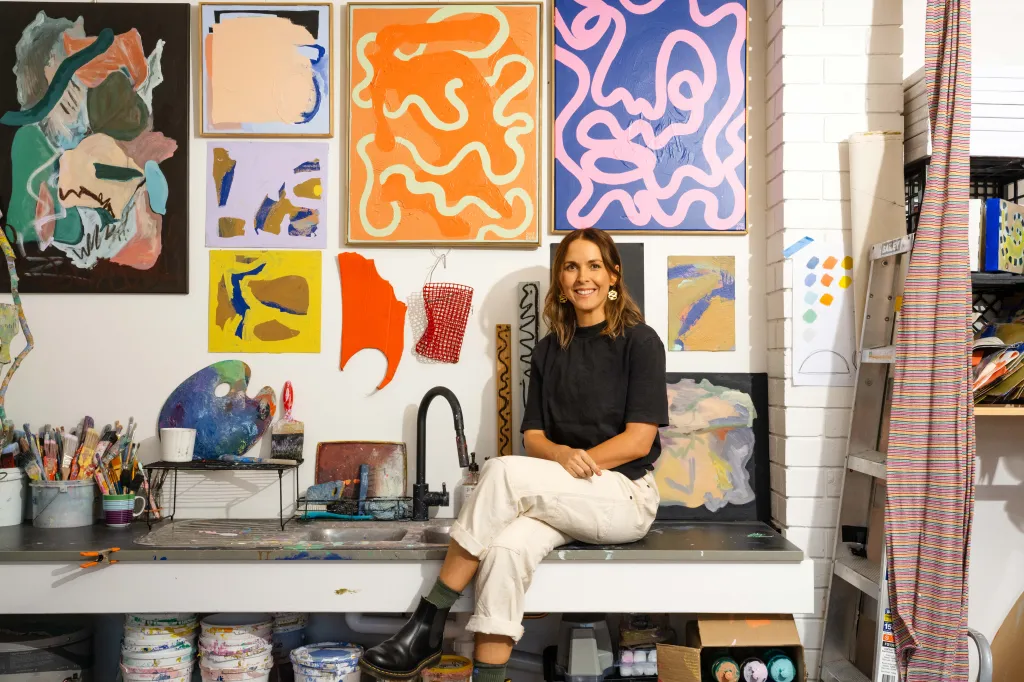Then and now: JamFactory looks to a new golden era
In the 50 years since it began life in an old factory in St Peters, JamFactory has helped forge hundreds of creative careers and put Adelaide at the heart of Australia’s contemporary craft and design scene. Now, as it reflects on the past and looks to the future, it has one pressing need: more space.

In November 1974, in the sprawling former Mumzone jam factory premises on Payneham Road, SA Premier Don Dunstan officially opened the latest addition to the state’s arts and crafts landscape.
By all accounts there were some challenges with the building, which was given only a superficial spruce-up for its new life. The glass studios at the back of the JamFactory premises flooded during heavy rain, and celebrated ceramicist Margaret Dodd – who at the time was working on her series This woman is not a car – has recalled that she had to put a plastic roof over her workspace to keep off the dust and pigeon droppings.
Nonetheless, it was the beginning of something special: an ambitious, not-for-profit enterprise incorporating ceramics, glass, jewellery, textiles and leather studios, as well as a retail space and gallery, with a focus on both training and the production of high-quality hand-crafted items for sale .
There was nothing quite like it then – or now – according to current JamFactory CEO Brian Parkes.
“In the 13-odd years I’ve been here, I’ve had bureaucrats and government ministers from other states and territories wanting to try to do something like JamFactory… and there just isn’t the economic or political will or enthusiasm,” he tells InReview from his office in the organisation’s current premises at the Lion Arts Centre in the West End of the CBD.
“It’s a big undertaking, but so is the return on the investment in this state – we have, per capita, the most extraordinary number of successful craft and design practitioners, which in turn attracts others.”

JamFactory’s original St Peters home in 1976 – today it houses apartments. Photo: supplied
The early 1970s was a golden era for the creative sector in Adelaide, and plans to establish JamFactory began to take shape when Dunstan sent Dick Richards (a craft jeweller and member of the Australia Council’s inaugural Crafts Board) on an overseas fact-finding tour. Parkes says the Premier was especially interested in how, post-World War II, the Scandinavians had harnessed their craft expertise and resources to create what we know as Scandinavian Modernism.
Richards returned with a string of recommendations that led to the establishment of the South Australian Craft Authority in 1973 and then, a year later, the launch of JamFactory.
At the opening event, Dunstan outlined his reasons for establishing the Craft Authority, including a desire to support the distinctive achievements of South Australia’s successful craftspeople, and to foster an environment in which such achievements influenced the “design criteria” of the state’s mass-production industries.
Most interestingly, given contemporary governments’ focus on economic bang for artistic bucks, he added: “Thirdly, we wanted to encourage the development or the continuation of rare or interesting skills… not because any one person or group of people would necessarily make a profit from such a program, but because it was a nice thing to do, a civilised thing to do.”
You might like

Jennifer Layther with trainees in the knitted textiles studio in 1985: Photo courtesy JamFactory
Old photos (see more below) offer a window into JamFactory’s first decade in St Peters. Beyond the building’s façade – which had been repainted chocolate brown in line with the current fashion – resident craftspeople have been captured blowing and melding molten glass to their creative will, throwing pots on the wheel, knitting textiles, and crafting leather belts and bags.
The ’70s and ’80s hairstyles and clothing may date the pictures, but the techniques are familiar – as are some of the faces. Jennifer Layther, now director of Arts SA and a JamFactory Lifetime Honouree, can be spotted in a photo taken in the knitted textiles studio, which she ran from 1982 until 1990.
Over the ensuing decades, JamFactory has undergone many changes, the most significant of which was the move to the Lion Arts Centre in 1992, when the textile and leather workshops closed, the jewellery workshop expanded to become the metal design studio, and a new furniture studio was introduced. At the time, Parkes says, a conscious decision was made to shift the emphasis slightly to explore commercial opportunities in the design space, as well as the crossover between contemporary visual arts and crafts.
In 2009, the retail space underwent a striking renovation designed by Khai Liew, and 10 years ago a second JamFactory gallery and retail space was opened at Seppeltsfield Winery in the Barossa Valley.

The JamFactory ceramics studio in 1989. Photo courtesy JamFactory
“At its core, JamFactory is about the materials and processes of a particular set of disciplines, and that’s been unchanged,” says Parkes.
“But the world around us has changed significantly, and the interest in authenticity and materiality and ethical sourcing of stuff and local production – the kind of things that happened in food 30 years ago – has increased [in recent times].
“People are wanting a more positive ethical connection with the things they consume and that’s benefitting people who work in the craft space.”
Parkes sees JamFactory’s 50th anniversary as a time for both celebration and reflection, adding that the institution means a lot to many people: “There’s an incredibly positive aura around it.”
A key focus of the celebrations is the anniversary exhibition GOLD, which is currently showing in one of JamFactory Adelaide’s two main gallery spaces and features a range of beautiful works by 50 of the around 500 artists, craftspeople and designers who have gone through its associate program over the years.
Curator Rebecca Freezer says she and Parkes wanted to illustrate the diverse career trajectories within craft and design across JamFactory’s current four key disciplines of ceramics, glass, furniture and metal. So while GOLD features pieces by well-known award-winning artists such as Clare Belfrage, Tom Moore, Honor Freeman and Liam Fleming, it also includes exhibitors who work as educators and mentors for a new generation of makers, and visionary business owners such as Gareth Brown of furniture-maker Agostino & Brown and Amanda Dziedzic of Melbourne-based Hothaus Glass Studio.
Freezer adds that JamFactory has spawned countless creative partnerships. “Not to mention the many romantic relationships that have blossomed at JamFactory, a small portion of which are represented in GOLD through the shared aesthetic of partners in life and work.”
The two earliest alumni featured in the exhibition are Peter Andersson and Bronwyn Kemp, who are also captured in those grainy photos from the early JamFactory studios. The pair were inaugural ceramic workshop trainees in 1979 and both later became heads of studio.
“Although Bronwyn returned to Sydney, where she continues to teach at the National Art School, she remains an important part of Jam’s history,” Freezer says. “Peter continues to tutor at the JamFactory Ceramics Studio teaching short courses to the general public as well as mentoring the next generation of associates. Both Bronwyn and Peter continue to make pots.”

GOLD showcases work from 50 JamFactory alumni. Photo courtesy JamFactory
Subscribe for updates
Since Parkes became CEO, moving to Adelaide from Sydney after previously holding roles at institutions such as the Museum of Contemporary Art and Australian Design Centre, JamFactory’s staff has increased from around 40 to more than 80.
Many are employed casually or part-time to assist with design and production in its studios, which produce bespoke items ranging from trophies to boardroom tables, as well as JamFactory-branded goods including homewares, furniture and lighting, which are increasingly in demand from architects and designers working on commercial projects.
“We see that as one of the most significant opportunities for growth – it’s not just financial growth for us, but creating opportunities for designers and helping to support local skills-based, craft-based manufacturing,” Parkes says.
Other key growth areas are retail sales and short-course workshops, where members of the public can learn everything from screen-printing and wheel-throwing, to how to hand-build a tea-set, sculpt a ceramic animal or craft a Shaker-style side table. JamFactory revamped and extended its short-course offering a few years ago, with more than 1200 paid participants undertaking courses in 2022.

Jewellery maker Danielle Barrie is one of the artists showing work in the GOLD exhibition. Photo courtesy JamFactory
“Some of it’s a reaction to the digital,” Parkes says. “So post-COVID, our fastest-growing revenue stream was our short-course workshops – people just wanted to get social and make things with their hands together. For some, it was about that social experience, and for others, it was about learning a skill that they’d always wished they’d learnt and never did.
“We’ve also had record growth in our retail sales. The two major years of COVID both saw record growth and then record growth again… instead of travelling, people were decorating their nests, but I don’t think that explains all of it. I think there was already some momentum happening around this more ethical or conscious or localised kind of consuming.”
Now, as it looks towards the future, Parkes says JamFactory’s most pressing need is for more space.
“It’s our number one priority. We’re bursting at the seams, and [we want to explore] things like the opportunity that exists for a textile studio, for a dedicated education space that would allow us to work more effectively with schools and teachers, and increased spaces that would enable us to do more of the commercial interface stuff.
“Imagine a licensed café with everything in it, from the glasses to the chairs to the tables to the lights, made by JamFactory.”

Annette Blair in JamFactory’s glass workshop at the Lion Arts Centre. Photo courtesy JamFactory
Rather than casting around for a new home, Parkes believes there is potential to do more with the “disjointed and under-loved public space” that is the Lion Arts Centre. He says JamFactory is keen to work with the State Government and other current tenants (who include Adelaide Contemporary Experimental, Nexus Arts, Mercury CX and Guildhouse) to explore the idea of reimagining the centre as a more dynamic and high-profile visual arts hub.
“We think there’s a strong argument for an architectural project which would be an adaptive reuse approach,” he says.
“So we recognise that the state might not be in a position to spend a hundred million dollars to do something flash and new on this site, but for a fraction of that you could probably repurpose the spaces to create something special that exploits the North Terrace address that we currently have our back to, that might not only provide the opportunity for expansion for an organisation like ours, but might also provide opportunities for some shared facilities and shared resources that might create efficiencies…
“We wouldn’t want to see any organisation disadvantaged in that – that’s really important. It would require a bunch of people working together.”
As part of its strategic plan, JamFactory is also committed to opening a shopfront in Sydney by 2028, with the intention that it would offer a base for promoting the organisation’s programs more widely, as well as housing a retail space.
In addition, the organisation plans to begin consultation with a view to introducing a pilot training program with improved accessibility for First Nations participants.
“This training program that we run, which has been so significant for 50 years, has actually failed to attract First Nations candidates, and we’ve tried for some time to address that without success,” Parkes says “So we’re determined to introduce a kind of parallel program.”
Looking out over the Lion Arts precinct from his first-floor office, Parkes reflects once more on JamFactory’s journey, acknowledging that in some ways it has come full circle since those early years when Dunstan’s bold vision to foster high-quality craft and design-based enterprises was set in motion.
“It’s an exciting time for the organisation. It feels like we’ve come of age… the foundations are now deep, there’s all this shared history, and so much goodwill invested in it by the whole community at a time when there is a renewed interest in the hand-made and in craft and in designing things better and in shared experience through hands-on experiences.
“It feels like we’ve survived a tumultuous few decades to be in the right place at the right time.”
GOLD: 50 Years 50 JamFactory Alumni is showing in Gallery One at JamFactory until September 17.

